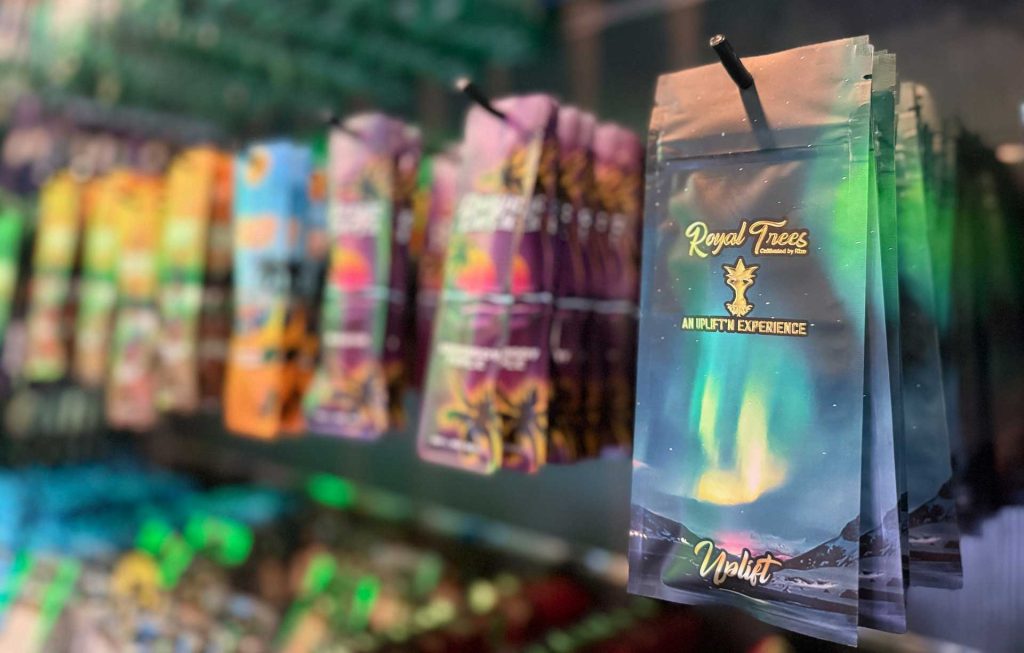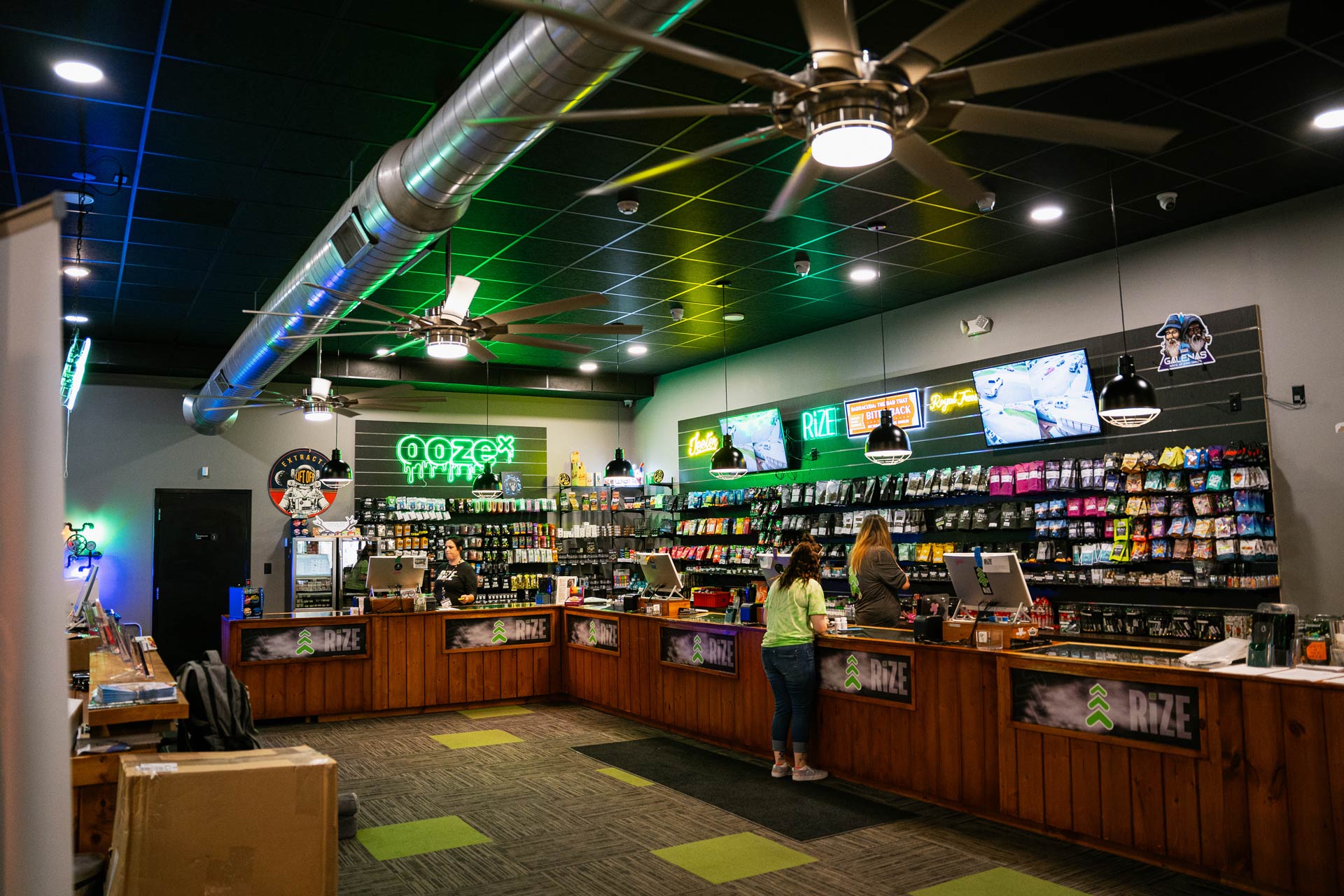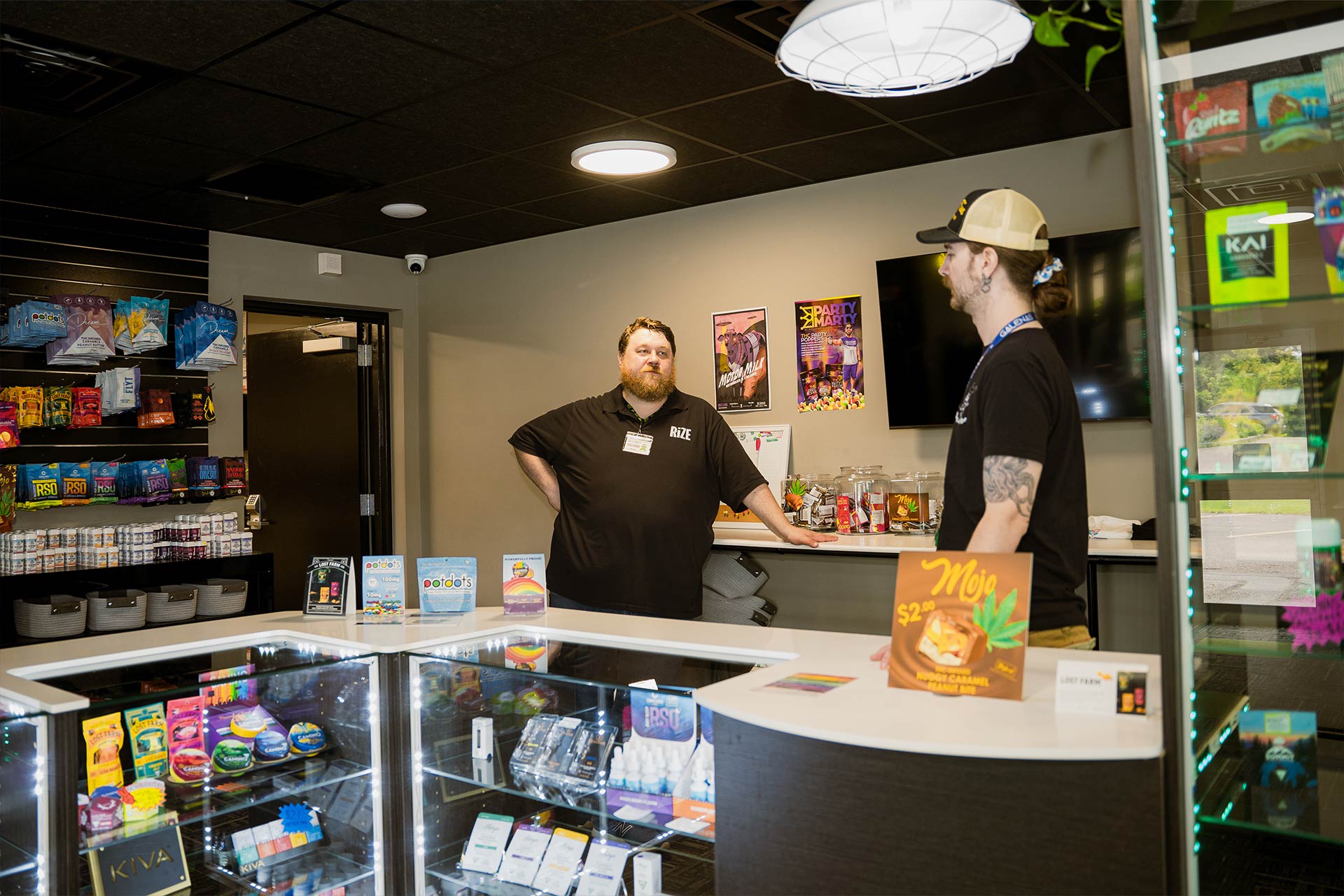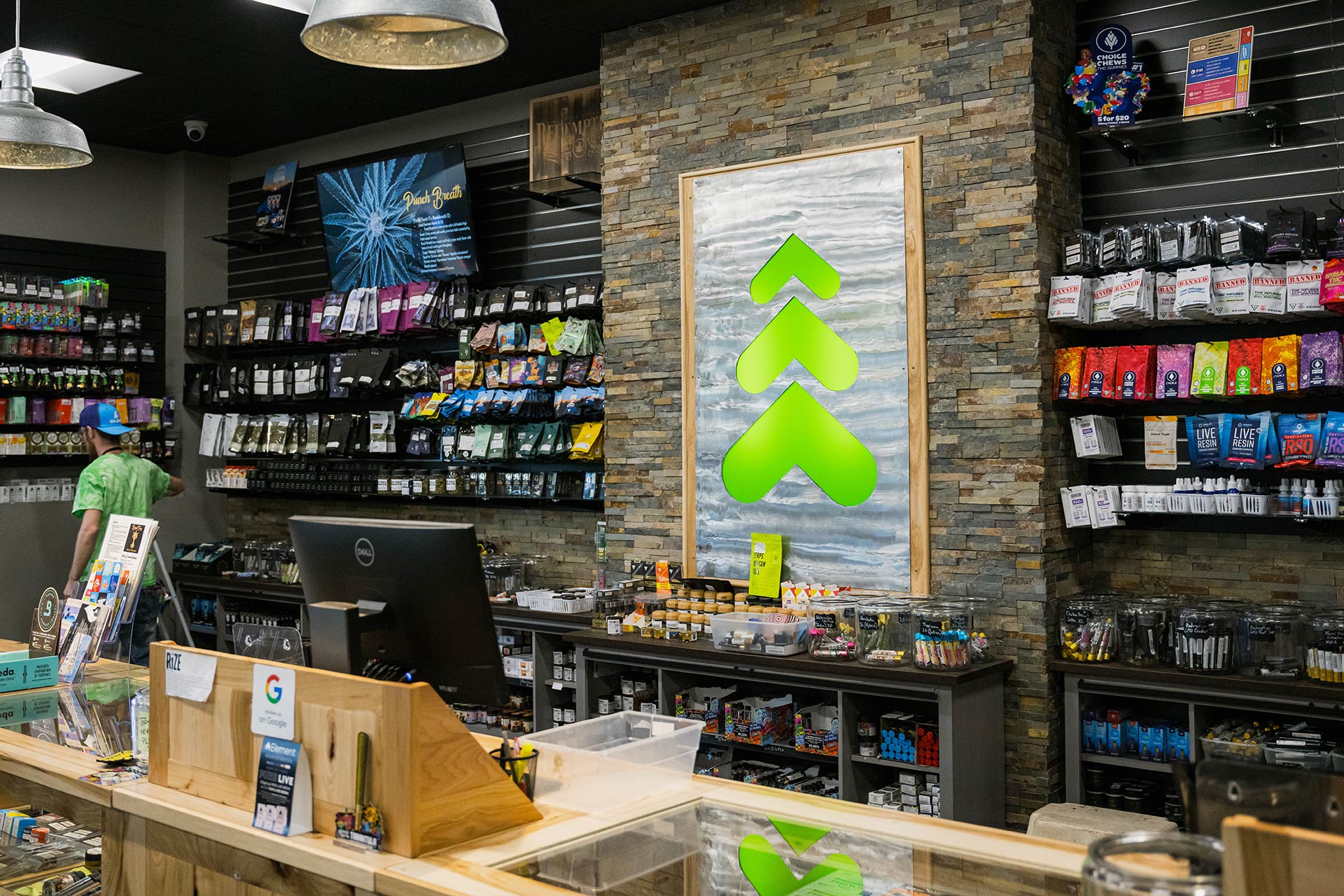Cannabis 101
Answers to Common Questions
Your Essential Guide to Products, Use, and Effects
Navigating the world of cannabis can be overwhelming, whether you’re new to it or a seasoned consumer looking to deepen your knowledge. Our Cannabis 101 FAQ is designed to provide clear, accurate, and practical answers to the most common questions about cannabis, its uses, effects, and products.
From understanding the difference between cannabis and hemp to learning about THC percentages, terpenes, and consumption methods, this guide breaks down the essentials so you can make informed decisions. We also cover legal guidelines, best storage practices, and how to handle overconsumption safely.
Simply click on a question to reveal the answer, and don’t hesitate to ask one of our Cannabis Consultants for more details during your next visit. Let’s dive in!

Cannabis 101
What’s the difference between cannabis and hemp?
Hemp and cannabis are the same plant. The major difference is that hemp is a mixture of male and female cannabis plants, and its flowers produce less than 0.3% THC. Hemp plants also tend to be taller and contain more fiber in their stalks. For this reason, hemp plants are often used to make textiles and can be used to make very strong forms of concrete.
How is cannabis used?
Cannabis can be smoked, eaten, vaporized or even used topically!
How much weed is in an 8th?
An eighth of cannabis is 3.5g, a quarter is 7g, half ounce is 14g and an ounce is 28g.
Most of our flower is prepackaged and all of MI regulated cannabis is governed by MDARD’s weights and measures program. You can ensure that all products sold by weight, measure or count declared the accurate amount. For more information please follow this link: https://www.michigan.gov/mdard/lab/weights/michigans-hemp-industry-and-the-states-weights-and-measures-law
What is Cannabis?
Cannabis is the dried leaves, flowers, stems, and seeds of the cannabis plant, also known as marijuana, weed, pot, or bud.
What is THC and how does it affect me?
Tetrahydrocannabinol (THC) is a cannabinoid found in cannabis. It is the principal psychoactive constituent of cannabis and one of at least 113 total cannabinoids identified on the plant. It’s the compound that gets you “high.”
Once in your body, THC interacts with your endocannabinoid system by binding to receptors, just like endocannabinoids. It’s powerful partly because it can bind to both CB1 and CB2 receptors. This allows it to have a range of effects on your body and mind, some more desirable than others. For example, THC may help to reduce pain and stimulate your appetite. But it can also cause paranoia and anxiety in some cases.
Experts are still trying to fully understand the endocannabinoid system, but so far, we know it plays a role in regulating a range of functions and processes, including:
- sleep
- mood
- appetite
- memory
- reproduction and fertility
The endocannabinoid system exists and is active in your body even if you don’t use cannabis.
What is the difference between THCa % and THC %?
THCa is a naturally occurring cannabinoid found in cannabis, and it is the precursor to THC. When cannabis is heated through smoking, vaping, or cooking; THCa undergoes decarboxylation, converting into THC (which then has psychoactive effects)
Most product labels list a THCa % and a THC %. The THC value is what you will be looking for when trying to determine the potency of the product. This THC % can vary by + or – 10% of the tested value. Meaning, if the THC is listed as 30%, and because 10% of 30 is 3, the total value could vary between 27% – 33%.
What are cannabinoids?
Cannabinoids are a class of chemicals found in cannabis plants and the human body. They can produce psychoactive effects and are used in medicine. Cannabinoids bind to receptors in the brain and body, which can change how cells behave and communicate
What is CBD/CBN/CBG/THCV?
These are all different cannabinoids found in the cannabis plant. Here’s a little more info about each of them.
CBD – Cannabidiol
- CBD is non-intoxicating.
- Neuroprotectant
- It is known for treating inflammation.
- May help with anxiety, mental illness, stress, neuropathic & inflammatory pain, seizures.
- When combined with THC, it could be a very effective treatment for pain,
CBN – Cannabinol
- Created when THC degrades during storage (exposure to oxygen, heat and UV light).
- Current research on CBN is limited to very few studies.
- Antibacterial properties
- Neuroprotectant
- The combination of CBN and THC can cause a sedative effect.
CBG – Cannabigerol
- Non-psychoactive
- Antibacterial
- More research is needed.
- CBGA is the precursor to the three main cannabinoids (THCA, CBDA, CBCA).
THCV – Tetrahyrocannabivarin
- THCV is a psychoactive compound.
- May help with diabetes and regulate blood sugar levels and reduce insulin resistance.
- There is little information about the effects of THCV.
What is the difference between Botanical terpenes & Cannabis Derived Terpenes?
Simply put, cannabis derived terpenes are extracted straight from the cannabis plant, and botanical terpenes are harvested from a wide variety of plants. However, both sources will contain many of the same terpenes. If you would like to learn more, please ask your Cannabis Consultant on your next visit.
What is Delta and what is the difference between Delta 8 and Delta 9?
Delta 9 THC
- Found in both the hemp and marijuana plant.
- Intense psychoactive properties.
- Federally illegal in quantities greater than .3%.
Delta 8 THC
- Mostly derived from industrial hemp.
- Psychoactive effects but not as intense as Delta 9.
- Federally legal
- We do not sell unregulated Delta 8 products at our facilities. Per CRA rules and regulations each product may contain no more than 10% of Delta 8.
What products have the highest THC?
For smoking, the highest THC percentage products would be a concentrate like resin or rosin, which also may be referred to as dabs. For edibles, RSO is the most potent. We also believe that highest THC % does not directly translate to the highest quality cannabis. There are many other factors to consider.
Where can I use cannabis?
Certified patients and adults 21 years of age or older may consume cannabis at home or in a private space (in Michigan). Please see your state’s specific laws and guidelines.
Will I pass a drug test after consuming cannabis products?
No, we cannot guarantee you will pass a drug test after using any of the products we carry.
How long does THC stay in my system?
Typically, THC is detectable between 1 day to a month or longer in urine (depending on how often the individual uses it), and up to 12 hours in blood. Please keep in mind, every person is different, and this will vary person-to person
How is the cannabis I purchase at a dispensary differ from the products from the black market?
The state of Michigan requires each regulated product we carry to go through a series of rigorous testing. Per CRA rules and regulations, we ensure to include a harvest date, THC percentages and other testing results on each package
For more information on how cannabis testing in Michigan works visit: https://www.cambiumanalytica.com/services/analytical-testing/test-library
Can I smoke or use cannabis in my vehicle?
No, consuming marijuana in a privately owned vehicle is prohibited regardless of whether you are driving or not.
Best storage practices (flower, concentrates, edibles).
- Flower: We recommend storing your flower in a cool, dark place with a consistent temperature between (60-70°F) Avoid storing it in the refrigerator or freezer.
- Concentrate: We recommend storing your container upright at room temperature or below. Freezing can help concentrate last longer, but it’s not ideal because it can cause freezer burn and moisture damage
- Edibles: We recommend storing them in the best packaging (which includes airtight containers) kept in a cool, dark place away from humidity. If you intend on storing them for longer, we recommend freezing them.
Can I drive after using cannabis?
No, driving under the influence of cannabis is a violation of Michigan’s Drugged Driving Laws.
What should I do if I overconsume?
If you get too high on cannabis, don’t panic—it’s temporary. Find a quiet, comfortable place to relax and take slow, deep breaths. Stay hydrated with water or juice, and avoid alcohol, which can worsen the effects. Distract yourself with calming activities like watching a comforting show, listening to music or talking with a friend. Most importantly, remind yourself that the feeling will pass.
What are the Cannabis categories on your menu and how are they used?
- Flower: There are several ways to consume flower. The most popular ways are to be smoked from a joint, blunt, pipe, or bong. It can also be cooked with if decarbed and infused with fat such as butter or oil.
- Pre-Rolls: Pre-rolls are good for smoking out of the tube. After it is lit evenly, place it between your lips and take a few, very small puffs to pull the burn upward and get it going.
- Vaporizers: With a 510 vape, attach to a battery. For a disposable, there is no need for extra hardware. After turning it on, take a steady puff, hold for a couple seconds, and breathe out.
- Concentrates: Top your flower, use a dab rig by heating up a blow torch, allowing to cool down and then placing the concentrate in and smoking, or an e-rig which will electronically heat your banger up.
- Edibles: Consumed by eating. If you are a first timer, start with a low dose of 2.5mg. Wait an hour or two and see how you feel. If the desired effects are not achieved, take another 2.5mg. Remember, you can always take more, but once you over consume you cannot reverse it.
- Tinctures: Place your dose under your tongue for 30-45 seconds before swallowing.
- Topicals: Rub on to your affected area of your body where you are experiencing pain.
- Beverages: Drink like a normal beverage. Most beverages are infused with a form of fast acting THC, so pay close attention to the dosage information on the packaging.
What does fast-acting (nano) edibles mean?
Fast-acting edibles, or nano edibles, use nano emulsion technology to infuse tiny, water-soluble cannabinoids into edibles. Unlike traditional edibles, which use fat-soluble cannabinoids. This means there is no need to wait for digestion for things to “kick in” so they typically take 15-20 minutes. The high itself is closer to smoking or vaping.
What are the different types of concentrates?
Rosin
- Made with heat and pressure.
- No solvents or chemicals are used.
- Full spectrum
- Great for connoisseurs.
RSO (Rick Simpson Oil)
- Thick, syrupy consistency
- Topical or ingested
- Great for high tolerance & intense symptom relief.
Kief
- Separation of trichomes from flowers.
- Powdery substance
- Ranges from off-white to dark green.
- Great for enhancing pre-rolls.
Live Resin
- Usually extracted with solvent extraction methods (butane, propane, etc.) in a closed-loop extraction system.
- Fresh, frozen material
- Great for average concentrate consumers.
Diamonds
- Little to no flavor on its own
- Terp sauce can be added (diamonds & sauce)
- Great for terpene allergies & connoisseurs
What are the different types of oils in cartridges?
Distillate
- Simple and inexpensive extraction without using solvents.
- Terpenes or other cannabinoids are reintroduced after distillation.
Rosin
- First processed with water and turned into hash.
- The hash is then pressed between two hot plates to extract the concentrate.
- Heat cured for consistency.
- Cleaner product (plant matter has been removed)
Full Spectrum
- Full profile of the cannabis plant.
- THC, THCa, CBD, CBDa, CBG, and CBN, terpenes, flavonoids & proteins.
- Creates the entourage effect which refers to the synergistic interaction between cannabinoids, terpenes, and other compounds in cannabis, enhancing their therapeutic benefits. This collaboration amplifies effects beyond what individual compounds achieve alone.
Live Resin
- Fresh plant extract
- Flash freezing (preserves truest terpene profile)
- Not always full spectrum extracts
Cannabis Effects
What is the difference between indica, sativa and hybrid?
- Indica strains or Broad Leaf Varieties are native to Afghanistan, India, Pakistan, and Turkey. They grow in harsh, dry, and turbulent climates. They generally have short and stocky, chunky leaves that grow wide and broad. They usually flower faster than sativa plants.
- Sativa strains or Narrow Leaf Varieties are native to Africa, Central America, Southeast Asia & portions of Western Asia. They grow best in hot, dry climates with long sunny days. They are tall and thin with finger-like leaves. These plants are usually tall, with less greenery than indica varieties and take a bit longer to mature.
- Hybrid strains are a combination of sativa and indica strains. Their appearance depends on the combination of the parent plants. Farmers and producers select hybrids for their unique impacts.
Lots of factors play a role in how cannabis effects an individual and all people react differently to different strains and products. In our opinion, we suggest that you keep a journal of notes for products and terpenes that give you the desired effects.
What are terpenes?
Terpenes are aromatic compounds found in many plants, though many people commonly associate them with cannabis because cannabis plants contain high concentrations of them.
These aromatic compounds create the characteristic scent of many plants, such as cannabis, pine, and lavender, as well as fresh orange peel. The fragrance of most plants is due to a combination of terpenes. In nature, these terpenes protect the plants from animal grazing or infectious germs.
However, terpenes may also offer some health benefits to the human body. As regulations surrounding cannabis become less strict, scientists are carrying out more research into these possible benefits.
- Limonene is a common terpene that most people can recognize by its scent. As the name suggests, limonene gives the rinds of fruits such as lemons and oranges their citrusy smell.
- A study in Chemico-Biological Interactions notes that limonene contains the following therapeutic properties:
- anti-inflammatory
- antioxidant
- antiviral
- antidiabetic
- anticancer
- A study in Chemico-Biological Interactions notes that limonene contains the following therapeutic properties:
- Pinene is another naturally abundant terpene. There are two forms of pinene: a-pinene and b-pinene. Pinene provides the fresh, bright scent of many plants, including pine needles, rosemary, and basil. Pinene may also have some therapeutic benefits.
Shirin-yoku, which means “forest bathing,” is a Japanese therapy that involves taking leisurely walks in the forest, soaking up the atmosphere, and enjoying the scent. Shirin-yoku may have preventive and restorative effects on a person’s psyche and physiology.
- Linalool is most abundant in the lavender plant and gives the flower its rich scent. Linalool is one of the more important compounds in aromatherapy and is responsible for the calming effect many people get when smelling lavender or its essential oil.
- A study in Colloids and Surfaces B: Biointerfaces note that linalool may affect the body in a variety of ways due to a range of properties, including:
- anti-inflammatory
- antimicrobial
- neuroprotective
- antidepressant
- anticancer
- anti-anxiety
- A study in Colloids and Surfaces B: Biointerfaces note that linalool may affect the body in a variety of ways due to a range of properties, including:
- Myrcene is a terpene commonly found in plants such as hops, lemongrass, and thyme. The flowers of the cannabis plant also contain myrcene. Myrcene is a powerful antioxidant.
- One study in mice concludes that myrcene could help protect the brain from oxidative damage following a stroke.
- Another study in mice found that myrcene had a similar protective effect in heart tissue. The researchers note that myrcene may be a useful alternative treatment after ischemic stroke.
- Beta-caryophyllene exists in many herbs and vegetables, such as cloves and black pepper. Like other terpenes, beta-caryophyllene may have an anti-inflammatory effect on the body that could reduce pain levels in some people.
- In one animal study, beta-caryophyllene reduced pain from inflammation and nerve pain.
- Researchers also noted that this anti-inflammatory and analgesic effect might be useful for treating long-term chronic pain because the body showed no sign of developing a tolerance to these effects.
- Humulene is a key component of the hop plant. Other plants, such as clove and ginger, also contain it.
- One study in Frontiers in Pharmacology notes that terpenes, including humulene, may have potential in preventing allergic reactions and asthma. In animal models, humulene reduced allergic inflammation in the airways. This could make it a helpful compound for natural asthma treatments in the future.
- Another study in Food and Chemical Toxicology found that humulene may also have a protective effect in some cells. This protective effect could guard against cancer. However, this is just preliminary evidence, and researchers must continue to study the effects of humulene to back up these claims.
Cannabis For New Users
Not all Cannabis is created equal.
We have products for beginners and advanced users. Not all products will be right for you. All of our products go through rigorous testing standards just to make it on our shelves, so you can be sure what you’re using is safe!
Look for CBD.
Pairing your THC with CBD can help combat some of the unpleasant side effects you can experience with THC.
Potency isn’t everything.
Look for a lower THC % flower to start and avoid vapes/ concentrates until you know how cannabis affects you. There are so many factors to finding the right products for you, but high THC % doesn’t mean a “better” medicine OR experience. Terpenes are the compounds that give the cannabis plant and its flowers a unique smell. These terpenes have unique combinations of therapeutic properties. Choosing the right strain with specific terpenes can be your best experience. Focus on strain effects; not the potency.
Take recommendations.
We have vast personal experience and knowledge about our products and dosing information. We are happy to help!
Where and when?
Timing and your environment can play a big role in the experience you have. Always consume somewhere you feel comfortable and safe. Make sure you have time to evaluate how you are feeling before you have to travel or go out in public.
Use caution with edibles.
Edibles affect us differently than smoking. They are more psychoactive and regardless if you are an experienced smoker or not, you could over do it! We suggest starting out with 2.5mg of THC. Always wait 2 hours before adding more to your dose. Depending on your body it can take that long for you to feel the effects. If you have no relief; add another 2.5mg of THC and repeat if necessary. The process takes patience!
You can prevent over-consumption.
All products have different potency and dosing information. Ask us to break it down for you! Smoking or ingesting too much cannabis can cause nausea, anxiety, lethargy, dizziness, and paranoia. We want to make sure you have the tools and information to avoid this completely.
Have a backup plan.
If you do over consume and feel overwhelmed, don’t panic. The feeling will soon pass! Make sure you can focus on something you enjoy (favorite movie/show, eat a snack, go for a walk, read a book, call a good friend). Stay hydrated and lay down or take a nap if necessary.
Shop Our Menus and Pre-Order Now!
Northern Michigan’s largest and most diverse selection of cannabis products




